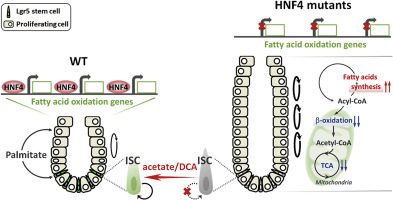当前位置:
X-MOL 学术
›
Gastroenterology
›
论文详情
Our official English website, www.x-mol.net, welcomes your
feedback! (Note: you will need to create a separate account there.)
HNF4 Regulates Fatty Acid Oxidation and Is Required for Renewal of Intestinal Stem Cells in Mice.
Gastroenterology ( IF 25.7 ) Pub Date : 2019-11-22 , DOI: 10.1053/j.gastro.2019.11.031 Lei Chen 1 , Roshan P Vasoya 2 , Natalie H Toke 2 , Aditya Parthasarathy 2 , Shirley Luo 2 , Eric Chiles 3 , Juan Flores 4 , Nan Gao 4 , Edward M Bonder 4 , Xiaoyang Su 5 , Michael P Verzi 6
Gastroenterology ( IF 25.7 ) Pub Date : 2019-11-22 , DOI: 10.1053/j.gastro.2019.11.031 Lei Chen 1 , Roshan P Vasoya 2 , Natalie H Toke 2 , Aditya Parthasarathy 2 , Shirley Luo 2 , Eric Chiles 3 , Juan Flores 4 , Nan Gao 4 , Edward M Bonder 4 , Xiaoyang Su 5 , Michael P Verzi 6
Affiliation

|
BACKGROUND & AIMS
Functions of intestinal stem cells (ISCs) are regulated by diet and metabolic pathways. Hepatocyte nuclear factor 4 (HNF4) family are transcription factors that bind fatty acids. We investigated how HNF4 transcription factors regulate metabolism and their functions in ISCs in mice.
METHODS
We performed studies with Villin-CreERT2;Lgr5-EGFP-IRES-CreERT2;Hnf4αf/f;Hnf4γCrispr/Crispr mice, hereafter referred to Hnf4αγDKO. Mice were given tamoxifen to induce Cre recombinase. Mice transgenic with only Cre alleles (Villin-CreERT2, Lgr5-EGFP-IRES-CreERT2, Hnf4α+/+, and Hnf4γ+/+) or mice given vehicle were used as controls. Crypt and villus cells were isolated, incubated with fluorescently labeled fatty acids or glucose analog, and analyzed by confocal microscopy. Fatty acid oxidation activity and tricarboxylic acid (TCA) cycle metabolites were measured in cells collected from the proximal half of the small intestine of Hnf4αγDKO and control mice. We performed chromatin immunoprecipitation and gene expression profiling analyses to identify genes regulated by HNF4 factors. We established organoids from duodenal crypts, incubated them with labeled palmitate or acetate, and measured production of TCA cycle metabolites or fatty acids. Acetate, a precursor of acetyl coenzyme A (CoA) (a product of fatty acid β-oxidation [FAO]), or dichloroacetate, a compound that promotes pyruvate oxidation and generation of mitochondrial acetyl-CoA, were used for metabolic intervention.
RESULTS
Crypt cells rapidly absorbed labeled fatty acids, and messenger RNA levels of Lgr5+ stem cell markers (Lgr5, Olfm4, Smoc2, Msi1, and Ascl2) were down-regulated in organoids incubated with etomoxir, an inhibitor of FAO, indicating that FAO was required for renewal of ISCs. HNF4A and HNF4G were expressed in ISCs and throughout the intestinal epithelium. Single knockout of either HNF4A or HNF4G did not affect maintenance of ISCs, but double-knockout of HNF4A and HNF4G resulted in ISC loss; stem cells failed to renew. FAO supports ISC renewal, and HNF4 transcription factors directly activate FAO genes, including Acsl5 and Acsf2 (encode regulators of acyl-CoA synthesis), Slc27a2 (encodes a fatty acid transporter), Fabp2 (encodes fatty acid binding protein), and Hadh (encodes hydroxyacyl-CoA dehydrogenase). In the intestinal epithelium of Hnf4αγDKO mice, expression levels of FAO genes, FAO activity, and metabolites of TCA cycle were all significantly decreased, but fatty acid synthesis transcripts were increased, compared with control mice. The contribution of labeled palmitate or acetate to the TCA cycle was reduced in organoids derived from Hnf4αγDKO mice, compared with control mice. Incubation of organoids derived from double-knockout mice with acetate or dichloroacetate restored stem cells.
CONCLUSIONS
In mice, the transcription factors HNF4A and HNF4G regulate the expression of genes required for FAO and are required for renewal of ISCs.
中文翻译:

HNF4 调节脂肪酸氧化,是小鼠肠道干细胞更新所必需的。
背景和目的 肠道干细胞 (ISC) 的功能受饮食和代谢途径的调节。肝细胞核因子 4 (HNF4) 家族是结合脂肪酸的转录因子。我们研究了 HNF4 转录因子如何调节新陈代谢及其在小鼠 ISCs 中的功能。方法 我们对 Villin-CreERT2;Lgr5-EGFP-IRES-CreERT2;Hnf4αf/f;Hnf4γCrispr/Crispr 小鼠(以下简称 Hnf4αγDKO)进行了研究。小鼠被给予他莫昔芬以诱导 Cre 重组酶。仅具有 Cre 等位基因(Villin-CreERT2、Lgr5-EGFP-IRES-CreERT2、Hnf4α+/+ 和 Hnf4γ+/+)的转基因小鼠或给予载体的小鼠用作对照。隐窝和绒毛细胞被分离,与荧光标记的脂肪酸或葡萄糖类似物一起孵育,并通过共聚焦显微镜进行分析。在从 Hnf4αγDKO 和对照小鼠的小肠近端收集的细胞中测量脂肪酸氧化活性和三羧酸 (TCA) 循环代谢物。我们进行了染色质免疫沉淀和基因表达谱分析,以确定受 HNF4 因子调节的基因。我们从十二指肠隐窝中建立了类器官,将它们与标记的棕榈酸盐或乙酸盐一起孵育,并测量了 TCA 循环代谢物或脂肪酸的产生。乙酸盐是乙酰辅酶 A (CoA)(脂肪酸 β-氧化 [FAO] 的产物)的前体,或二氯乙酸盐是一种促进丙酮酸氧化和线粒体乙酰辅酶 A 生成的化合物,用于代谢干预。结果隐窝细胞迅速吸收标记的脂肪酸和 Lgr5+ 干细胞标记物(Lgr5、Olfm4、Smoc2、Msi1、和 Ascl2) 在用 FAO 抑制剂乙莫克西孵育的类器官中被下调,表明 FAO 是 ISC 更新所必需的。HNF4A 和 HNF4G 在 ISC 和整个肠上皮细胞中表达。单敲除 HNF4A 或 HNF4G 不影响 ISC 的维持,但双敲除 HNF4A 和 HNF4G 会导致 ISC 丢失;干细胞无法更新。FAO 支持 ISC 更新,HNF4 转录因子直接激活 FAO 基因,包括 Acsl5 和 Acsf2(编码酰基辅酶 A 合成的调节因子)、Slc27a2(编码脂肪酸转运蛋白)、Fabp2(编码脂肪酸结合蛋白)和 Hadh(编码羟酰辅酶 A 脱氢酶)。在 Hnf4αγDKO 小鼠的肠上皮细胞中,FAO 基因的表达水平、FAO 活性和 TCA 循环的代谢产物均显着降低,但与对照小鼠相比,脂肪酸合成转录物增加。与对照小鼠相比,标记的棕榈酸酯或乙酸酯对 TCA 循环的贡献在源自 Hnf4αγDKO 小鼠的类器官中减少了。用乙酸盐或二氯乙酸盐孵育源自双基因敲除小鼠的类器官可恢复干细胞。结论 在小鼠中,转录因子 HNF4A 和 HNF4G 调节 FAO 所需基因的表达,并且是 ISC 更新所必需的。
更新日期:2019-11-22
中文翻译:

HNF4 调节脂肪酸氧化,是小鼠肠道干细胞更新所必需的。
背景和目的 肠道干细胞 (ISC) 的功能受饮食和代谢途径的调节。肝细胞核因子 4 (HNF4) 家族是结合脂肪酸的转录因子。我们研究了 HNF4 转录因子如何调节新陈代谢及其在小鼠 ISCs 中的功能。方法 我们对 Villin-CreERT2;Lgr5-EGFP-IRES-CreERT2;Hnf4αf/f;Hnf4γCrispr/Crispr 小鼠(以下简称 Hnf4αγDKO)进行了研究。小鼠被给予他莫昔芬以诱导 Cre 重组酶。仅具有 Cre 等位基因(Villin-CreERT2、Lgr5-EGFP-IRES-CreERT2、Hnf4α+/+ 和 Hnf4γ+/+)的转基因小鼠或给予载体的小鼠用作对照。隐窝和绒毛细胞被分离,与荧光标记的脂肪酸或葡萄糖类似物一起孵育,并通过共聚焦显微镜进行分析。在从 Hnf4αγDKO 和对照小鼠的小肠近端收集的细胞中测量脂肪酸氧化活性和三羧酸 (TCA) 循环代谢物。我们进行了染色质免疫沉淀和基因表达谱分析,以确定受 HNF4 因子调节的基因。我们从十二指肠隐窝中建立了类器官,将它们与标记的棕榈酸盐或乙酸盐一起孵育,并测量了 TCA 循环代谢物或脂肪酸的产生。乙酸盐是乙酰辅酶 A (CoA)(脂肪酸 β-氧化 [FAO] 的产物)的前体,或二氯乙酸盐是一种促进丙酮酸氧化和线粒体乙酰辅酶 A 生成的化合物,用于代谢干预。结果隐窝细胞迅速吸收标记的脂肪酸和 Lgr5+ 干细胞标记物(Lgr5、Olfm4、Smoc2、Msi1、和 Ascl2) 在用 FAO 抑制剂乙莫克西孵育的类器官中被下调,表明 FAO 是 ISC 更新所必需的。HNF4A 和 HNF4G 在 ISC 和整个肠上皮细胞中表达。单敲除 HNF4A 或 HNF4G 不影响 ISC 的维持,但双敲除 HNF4A 和 HNF4G 会导致 ISC 丢失;干细胞无法更新。FAO 支持 ISC 更新,HNF4 转录因子直接激活 FAO 基因,包括 Acsl5 和 Acsf2(编码酰基辅酶 A 合成的调节因子)、Slc27a2(编码脂肪酸转运蛋白)、Fabp2(编码脂肪酸结合蛋白)和 Hadh(编码羟酰辅酶 A 脱氢酶)。在 Hnf4αγDKO 小鼠的肠上皮细胞中,FAO 基因的表达水平、FAO 活性和 TCA 循环的代谢产物均显着降低,但与对照小鼠相比,脂肪酸合成转录物增加。与对照小鼠相比,标记的棕榈酸酯或乙酸酯对 TCA 循环的贡献在源自 Hnf4αγDKO 小鼠的类器官中减少了。用乙酸盐或二氯乙酸盐孵育源自双基因敲除小鼠的类器官可恢复干细胞。结论 在小鼠中,转录因子 HNF4A 和 HNF4G 调节 FAO 所需基因的表达,并且是 ISC 更新所必需的。











































 京公网安备 11010802027423号
京公网安备 11010802027423号